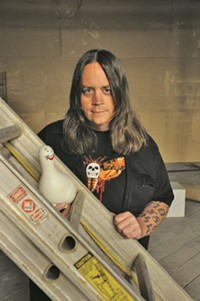It’s like a bait-and-switch, the way The War on Drugs’ songs lead you to expect artisan choruses a la Petty and Springsteen. Or Tweedy. Except, when Adam Granduciel and Co. don’t deliver one, you don’t feel cheated. By the tune’s fadeout, you’re as satisfied as if there were a big chorus, because the payoffs aren’t concentrated in a handful of bars; they’re everywhere.
“I think with us, there are all these little things to latch onto,” Granduciel says. “I work real hard on the songs and try to give them their own little identity. ... It’s not a conscious thing, to not have choruses, but it’s just kinda the way I feel comfortable writing—and kinda crafting—songs.”
We like to portray songwriters as craftspeople, hailing their craftsmanship as though they make canoes instead of songs. It’s probably a way of assigning tactility to the intangible, of putting a finger on something we don’t understand. Boats get us across water, but songs elicit physical and emotional responses that ferry us through life. So we elevate songwriters to a level above us and worship them as ascended masters. But if we view them in a more workmanlike context—call them craftsmen—suddenly it’s easier to relate to them as people.
For someone who draws comparisons to some of the greatest songwriters, Granduciel is grounded—very much a regular dude. He didn’t want to answer the phone to do another interview while the band’s vehicle chugged along to the next town. He admitted as much, and even that he tried to pawn it off on one of the other three guys. That’s an honesty you don’t see in many people, and, of course, it seeps into his songs.
The tracks on the Philadelphia-based quartet’s second full-length album (not counting three EPs), Slave Ambient, are as sparse and as vast as a Cormac McCarthy novel. Rife with description and action, but omitting character names, dialogue attributions and sometimes punctuation—elements that, like choruses to songs, are ostensibly essential to literature—they nonetheless communicate volumes. Notwithstanding the absent choruses, they’re anthemic. And, couched in gauzy instrumentation and studio trickery, occasionally prefaced by instrumental interludes that Granduciel says “reference the other songs on the record,” they take on a cinematic feel. The listener is dropped into short-film microcosms for a strangely edifying escape into a world that belongs to someone else, but is just like yours.
“I guess I want all the songs to connect and feel like a record,” Granduciel says. “That’s kind of the other way to take somebody there, instead of stringing together this kind of song and that kind of song. That’s what I like that’s most honest about writing.”
There’s another level to the construction: Granduciel assembled the songs from bits and pieces—literally. The songs are a patchwork of musical ideas, some actually smaller than verses, choruses or chord progressions. Imagine him putting everything together, tinkering in a workshop—again, images of craftsmanship. Knowing the intent, how Granduciel cares to weave an intensely satisfying experience for his audience, makes Slave Ambient a joy to hear. You feel like, as Granduciel sings nasally and Dylan-esque in “Come to the City,” that “it was made just for me.”
That’s the kind of music that lasts forever. Like Petty and Springsteen, artists whom so many of us experience through greatest hits, they get there for a reason. They started by making their first fans feel like their only fans, and by writing songs that create a sense of communion decades after the fact—by being craftsmen first and working hard to create something meaningful that the listener will return to repeatedly over the years.
“All the songs I worked on for a long time,” Granduciel says. “But it was never one thing was done and then we started another thing. They were worked on all together, so you keep coming back to each one. It’s unified, that way.”
THE WAR ON DRUGS
w/ Purling Hiss, Carter Tanton
Kilby Court
741 S. Kilby Court (330 West)
Saturday, Oct. 29, 7 p.m.
$8 in advance, $10 day of show
More by Randy Harward
-
Live Music Picks: April 19-25
MC Chris, Talia Keys & the Love, Nick Passey, Brian Wilson and more.
- Apr 18, 2018
-
Live Music Picks: April 12-18
Judas Priest, The Residents, Clownvis Presley, The Breeders and more.
- Apr 11, 2018
-
Rock-It Fuel
Local musicians dish on the grub that puts the bomp in their bomp-bah-bomp-bah-bomp.
- Apr 11, 2018
- More »
Latest in Music
Readers also liked…
-
The Alpines Head North
Local band's debut concept album finds musical bliss in the apocalypse.
- Feb 7, 2024










